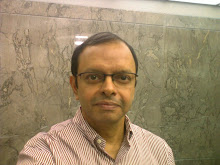It has all the build-up and drama of a blockbuster Bollywood pot boiler and is reminiscent of the Sholay saga that many of us feasted on! A valiant Prime Minister supported by robust rural growth weathers the monster called the Recession of 2008 and India emerges in 2009 as the only economy to remain relatively unscathed by the economic slowdown. But after this the government has to beat back successive raids on its credibility by the dacoits of the 2G scam, the Commonwealth Games fiasco and most recently Coalgate. The Prime Minister, his reputation battered by the successive scams and the attacks on his government by critics like Team Anna, the foreign Press and even his coalition friends had seemingly lost the ability to take the fight to the opposition and one cartoonist interestingly depicted the whole economy spinning into a cesspool from which there were dim chances of recovery.
But even as the Bollywood movie Sholay saw two new heroes come into the act to support the protagonist, twenty-four hours of seemingly unconnected but highly timely acts have brought new life to this government and renewed cheer to India watchers as well as the business community in the country. The announcement of the new US Quantitative Easing programme—QE3 brought cheer to the global stock markets one Thursday evening and the raft of initiatives—rise in diesel prices, reduction of handouts and subsidies, FDI in retail and aviation and aggressive disinvestment announcements have demonstrated clear intent for fiscal consolidation.
There is also a strong expectation from India Inc that the Reserve Bank will come to the party and provide the much awaited rate cut and align the monetary policy to the growth agenda by cuts in the cash reserve ratio and other initiatives. The recently reinstated finance minister has hinted at “calibrated risks” which augur well for monetary and fiscal policy announcements that will lift the mood of industry and consumers before the Diwali spending season and pave the way for employment pickup and renewed economic growth.
However, the Sholay analogy does not end there. The heroes of this drama, the finance minister and commerce minister, having fired the first volley of economic bullets will have to be on their guard against the ability of their many opponents to damage their credibility by raising the ire of the voting public. Let us not forget that corporate or middle class India is not really the constituency that any politician looks at. The twin demons of the diesel price rise with its resultant impact on the inflation level which is already trending at much higher than predicted or desirable levels and the expected opposition to the opening up of multi-brand retail because of its likely negative impact on manufacturing as well as the neighbourhood “kirana” store will be used in street agitations and television rhetoric to threaten the downfall of the government and it will need steely resolve and a genuine “if we go down we will go down fighting” approach for the bold moves to result in actual success.
For the IT sector in India, these are interesting times and there are enough indicators to watch out for. The strongest ever single session rise for the rupee against the dollar in recent times has the potential to rain on the parade of exporters if the rupee, widely expected to touch 60 by end of the year, goes the other way and touches 50 instead. However the good news is that if both government and industry spending revives with the “feel good” factor giving a boost to market capitalisation and consumer and business to business industrial demand, the propensity to invest in productivity and better IT solutions will come back into contention.
The biggest beneficiary of a sustained economic resurgence will of course be the tens of millions of job seekers who have been despairing about the weak availability of jobs in the IT sector and the literal stoppage of recruitment in most other sectors of business and industry. Speaking at multiple seminars for human resource managers and academic institutions in the last month and more, the despair I have seen has been palpable and fundamental questions have been asked about the seesaw game that is being played between investment in people and protection of profits. In a growth economy, the people factor will provide the “lift” that is needed to build higher capabilities and increase India Inc’s competitiveness in global markets.
There has been an enthusiastic response from the CII and corporate chiefs, despite the skepticism in some quarters of the impact of these moves on the power and infrastructure sectors as well as the muscle the protagonists will show when faced with the political counter attacks of various parties. However we live in hope that India will rediscover her 8% growth in the not so distant future.







